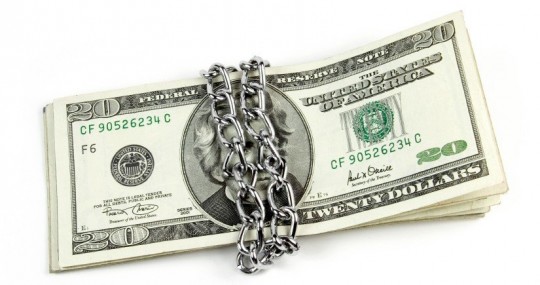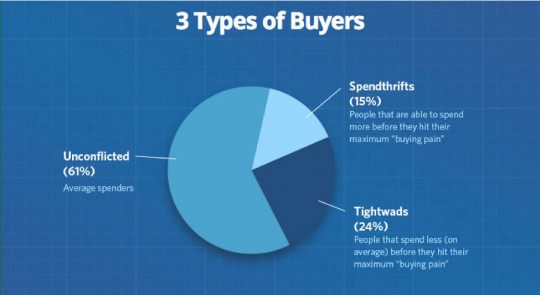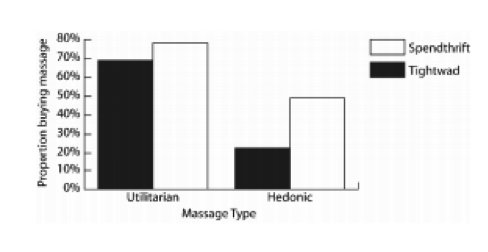
[Guest post by Jeremy Smith.]
I absolutely love buyer psychology and neuroeconomics. Want to know why?
● Because it’s like a secret weapon that produces torrents of conversions (and money).
● Because it’s the only real way to understand why and how buyers make purchases.
● Because it’s the proven route to successful marketing.
● Because it’s guaranteed to squash the competition.
The thing is, a lot of people are scared of psychology. They think it’s somehow uber-advanced, highly technical, and inaccessible to most ordinary Homo sapiens. They think that you have to read articles like this one:

Ah, yes, I remember that one…the stimulating discussion about how the central amygdaloid nucleus projects to brainstem and hypothalamic nuclei mediating fear responses and receives convergent sensory inputs from the basolateral amygdaloid complex… Makes perfect sense….
(To be completely transparent, I didn’t actually read that article.)
Buyer psychology isn’t something to be afraid of. It’s something to be embraced. In the following article, I’m going to make things very simple — not because I underestimate your intelligence, but because buyer psychology itself is not complex.
I can break it down into three points.
Introduction
The big idea behind my article is this: There are three main types of buyers. To sell more products and services you need to understand how to appeal to each type of buyer.
It’s that simple. What I’m going to do, then, is this:
1. Give you a brief introduction to the 3 types of buyers.
2. Explain some characteristics of each type of buyer.
3. Share several advanced tips for selling to each type of buyer.
What are the 3 Types of Buyers?
I’d like to introduce you to the tightwad, the spendthrift, and the average spender. These three are the main types of buyers identified by neuroeconomics experts
1. Tightwads — “I’m not spending my money unless you pry it out of my grubby hands.”
Tightwads love saving. They hate spending. They will hold on to their money as long as they can. These are the people that spend less than the average Joe, save more than the average Joe, and get more anal in response to salespersons and commercials than the average Joe.
This is not the average Joe. This is Scrooge.
They love their money, as long as it’s sitting safely in a late maturing CD or an extra secure savings account.
2. Spendthrifts — ”I’m going to spend all the money I possibly can, and then some!”
Ah, the spendthrift. This is the marketer’s dream customer. They love spending money. What’s money for?! It’s to be spent!
Spendthrifts are why credit card companies make money. These people will spend until they max out that credit card, then reach for the next credit card and keep going. This is the proverbial “impulse buyer” unleashed.
They need little more convincing then “It’s for sale.”
3. Average Spenders — “If it seems like a good investment, I’ll purchase it.”
Here’s most of us. We spend what we think is appropriate. We think about purchases. We weigh options, take time to decide, and, generally, try to make smart moves and save a little money.
Marketing doesn’t have a one-size-fits all hat for everyone to buy and wear. You need to speak differently to different types of people.
Let’s take a look at how many tightwads, spendthrifts, and average buyers there are:

Image from https://www.helpscout.net/resources/consumer-behavior/
As would be expected, most buyers are average. Obviously, that’s where most savvy marketers will spend their marketing dollar and effort. But don’t forget about LOE (level of effort) vs. payoff. For example, if a small amount of effort could produce more revenue from spendthrifts, then it would also make sense to create a marketing plan that addresses these buyers. Little effort. Lots of conversions? Why not.
But tightwads are pretty hefty percentage of the population. Nearly a quarter of the people you need to sell to are keeping their cash clenched in their fist or squirreled away under their mattress. You’ll probably want to give them some level of attention.
What are the characteristics of the 3 types of buyers?
Now, let me go deeper into the characteristics of each of these 3 types of buyers. Let’s make sure we truly understand some of the driving forces and shaping influences of these people.
1. Tightwads
Tightwads anticipate spending pain and respond by not buying.
You’ve heard of buyer’s remorse. Maybe you’ve felt it. Tightwads feel it, too. But the thing is, they anticipate the pain much more acutely than most.
According to the research, “An anticipatory pain of paying drives ‘tightwads’ to spend less than they would ideally like to spend.”
Tightwads are controlled by the amount that they think a product should cost.
The attitude of a tightwad toward and expenditure depends upon how much he or she thinks it should cost. However, this amount is usually skewed low in keeping with the budget-sensitive nature of the tightwad.
Tightwads are unable to “indulge.”
Economic research has shown that certain types of people — those who fall into the tightwad category — refuse to indulge themselves in luxuries or expenditures. These are the ascetics, more likely to join a monastery then to enjoy a vacation on the French Riviera.
Studies (Ameriks et al.) show that, “some people find it painful to indulge.” In addition to the pain of purchase, they feel the pain of comfort, too! They don’t buy massages, as indicated in this survey:

Image from a study by Rick, Cryder, and Loewenstein.
Tightwads are planners and budgeters.
Planners are people who can not only anticipate outcomes, but also have the foresight to prepare for them.
Occasionally, though, foresight can turn into farsightedness. With a more apocalyptic doomsday approach to life than most, these people may dig bomb shelters and stockpile Campbell’s soup. It’s certainly prudent to do so, but it is also concurrent with their disinclination to spend any money.
2. Spendthrifts
Spendthrifts experience no buyer’s remorse.
The sensation of “buyer’s remorse” that many of us feel is foreign to the spendthrift. They are oblivious to such pain. In fact, they actually get their good feelings from being able to spend money. The more money they spend, the better they feel.
Spendthrifts do not anticipate spending pain.
Since spendthrifts don’t experience buyer’s remorse, they don’t anticipate the remorse, either. Their brain operates in such a way that the idea of “spending money” actually causes the brain’s pleasure centers to light up. This is in complete contrast to the tightwad who experiences the opposite sensation.
Spendthrifts are not regulated by a premeditated budget or spending plan.
“Budget” is not part of the spendthrifts’ vocabulary. Very few controlling factors influence the spendthrift spending patterns. The only “controls” are those that create positive feelings.
Spendthrifts experience price blindness, or a favorable high-price bias.
Here’s a conversation of how a spendthrift and an average spender might look at a dress:
Spendthrift: “Oh, gosh, look at that darling dress. It’s so cute!”
Average spender: “Wow. It’s expensive!”
Spendthrift: “Aaagh!! I never seen anything so adorbs!”
Average spender: “But it costs $1,649!”
Spendthrift: “You know, I think this would be perfect for Charlie’s party on Saturday night.”
[At this point, the average spender and spendthrift are on completely different wavelengths. They aren’t able to communicate with each other about the dress.]
Average spender: “I’m going to go check out the sales rack.”
Spendthrift: “Oh my! [Squeal] It’s in my size! I’m going over to the checkout counter.”
More often than not, spendthrifts disregard the price tag. They don’t experience “sticker shock.” Instead, they focus on the appeal of having the product or service. They are driven by emotions.
In some cases, spendthrifts equate a higher price point with a better product or service. Rather than analyze the benefits or features of the product or service, they consider the purchase purely from the perspective of a higher price.
3. Average Spenders
Spendthrifts and tightwards represent polar opposites in buyer behavior. The best way to sum up the attitudes and actions of average spenders is simply to say that they fall somewhere in between the two extremes.
Here are some specific characteristics:
Average spenders have a rough idea of their budget.
While most Americans don’t have a strict budget, they do have a basic idea of how much money is coming in vs. how much is going out. What more is a budget, but a guide that tells you income vs. expenditures?
With these rough figures in mind, the average spender knows if they can afford something, and acts accordingly.
Average spenders occasionally impulse buy or overbuy.
Few people can completely control their spending in every single area. Maybe you’re excellent at controlling your spending on going out to eat or buying snacks, but you simply can’t resist the luxury cars.
All of us have our weaknesses, and that’s why even “average spenders” have the occasional behavioral outburst of a spendthrift of a tightwad.
Average spenders carefully consider value propositions, benefits, and features.
In other words, average spenders are able to look at a purchase rationally. They read through the bullet lists of “benefits.” They follow along the comparison charts that you created comparing your services with the competitor’s. They consider the variety on Netflix before deciding on a subscription. They even read those small numbers in the grocery store that say “price per ounce.”
Average spenders are influenced by facts and data, even if they aren’t completely controlled by this information.
Facts and data have an affect on the average buyer. But they are also influenced by messaging. Both the emotional and the analytical messaging should be present in order to fully persuade the average spender.
Average spenders think about their decision for a while.
Most people don’t make a purchase on their first visit to a website. Instead, they come back after they’ve thought about it, looked at comparison products, or searched for coupon codes. Basically, they think about it.
How do you sell to the 3 types of buyers?
So, now that you understand the three types of buyers and have a sense of their characteristics, and proclivities, how do you sell to them?
The answer to that question is the substance of many more articles. To be brief, I’ll bullet out a few of the big-picture strategies for selling to each of the three types.
1. Selling to a Tightwad
As a large percentage of your potential customer base, you need to spend some time trying to sell to these guys.
● A tightwad probably won’t spend money on something unless it is within his or her budget.
● Sell using negative emotional signals, not positive or indulgent ones. In other words, don’t use messaging like “You deserve” or “this is the best for you.” Instead, use messaging like “Losing money hurts” or “Save your money and secure the best future for your family.”
● They will respond to value propositions more than they will respond to clever emotional tricks, slogans, or appeals.
● Use numbers, data, charts, and metrics. The decision-making process of a tightwad is analytical, precise, and straightforward. He can smell BS a mile away, and doesn’t have the time of day for it. To truly persuade, you’re going to have to address this analytical style of thinking with honest claims, detailed numbers, and well-researched information.
Selling to a Spendthrift
They don’t require much convincing if they are in your target market. Nonetheless, here’s what works best:
● They will respond to emotional advertising. The spendthrift dispenses with analytics processing, and acts from the heart.
● They will respond to pictures. In keeping with the emotional power of spendthrifts, keep your visual marketing high. They will respond. Remember, pictures of babies and dogs are always appealing.
● They will respond to colors. Color psychology plays an important role in the behavior of spendthrifts. Use it strategically.
Selling to Average Buyers
As the largest slice of the pie graph, you need to focus the majority of your marketing on this population. Average buyers are smart, but they share, in moderation, some of the characteristics of the previous two groups:
● They respond to a mix of emotion-driven and metric-driven marketing messages. True to their nature as between-the-extreme buyers, your average customer base is going to respond to some of the numbers in your marketing, and some of the emotional appeal in your marketing. Use both.
● They like guarantees, returns, warranties, and free shipping. Most average buyers are suckers for the extra. Most average people are just looking for a good deal. All the extra stuff like guarantees, free shipping, etc. — this could tip them in favor of a purchase.
Conclusion
Knowing buyer psychology can make or break your marketing efforts. Ignore it at your peril. Embrace it to your profit.
Although it can be frightfully complex, the core ideas in neuroeconomics are startlingly simple. There are three types of buyers. Know them, address them, serve them, and they will buy from you.